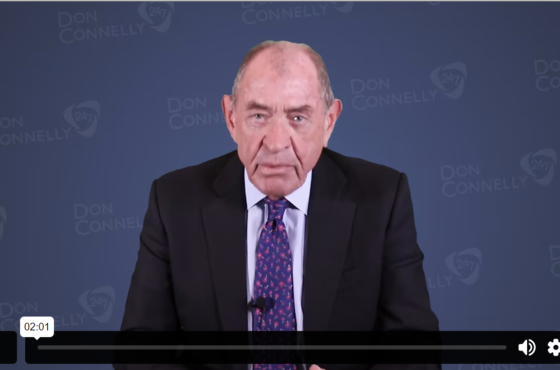How Financial Advisors Can Create Engaging Financial Presentations
 A significant challenge for financial advisors is translating complex financial concepts into terms clients can easily digest. For many, presentations serve as an effective medium for closing the gap between what advisors know and what clients can understand. However, many advisors struggle with transforming intricate concepts into accessible content and maintaining their client’s interest throughout the presentation.
A significant challenge for financial advisors is translating complex financial concepts into terms clients can easily digest. For many, presentations serve as an effective medium for closing the gap between what advisors know and what clients can understand. However, many advisors struggle with transforming intricate concepts into accessible content and maintaining their client’s interest throughout the presentation.
Advisors must elevate their presentation chops when presenting at client meetings, educational workshops, or public seminars. Here are some critical strategies advisors can use to prioritize clarity, engagement, and professionalism when delivering financial presentations.
#1. Know your audience
The foundation of a successful financial presentation lies in understanding your audience. Financial advisors often work with diverse clients—young professionals navigating their first investments, retirees safeguarding their wealth, or business owners planning for growth. Each group comes with varying levels of financial knowledge and distinct priorities.
To tailor your presentation effectively, consider these steps:
Segment your content
Young professionals are more likely to value information on future growth and basic financial literacy. Retirees want information on wealth preservation and healthcare planning.
Speak their language
Avoid overwhelming clients with jargon. Replace terms like “asset allocation” with phrases like “how we spread your investments to reduce risk.”
Anticipate concerns
For example, business owners may ask how economic changes affect their operations. Addressing such concerns upfront demonstrates preparedness and builds trust.
By understanding your audience’s needs, you can craft a presentation that feels personal and relevant, ensuring your message resonates.
#2. Simplify complex financial concepts
Financial topics are often dense, and a presentation packed with technical details can alienate clients. Simplifying these concepts without diluting their importance is an art every financial advisor should master.
Break it down
Divide information into small, easily digestible sections. For instance, when explaining retirement planning, start with the basics of savings, move to investment options, and conclude with distribution strategies.
Use analogies
Relatable comparisons can demystify complex topics. For example, comparing a diversified portfolio to a balanced meal helps clients understand the value of variety.
Avoid information overload
Instead of presenting the entire financial landscape, focus on 2-3 actionable points clients can relate to and implement.
Simplification builds confidence, enabling clients to make informed decisions without feeling overwhelmed.
#3. Utilize visuals and data effectively
Visual aids are powerful tools for enhancing comprehension and retention. A well-designed slide deck not only grabs attention but also reinforces your message.
Leverage infographics and charts
Visual representations like pie charts for portfolio allocation or graphs showing investment growth over time make data intuitive and memorable.
Keep slides clean
Limit each slide to one main idea with a few supporting visuals or bullet points. A cluttered slide detracts from the message.
Use professional tools
Software like PowerPoint, Canva, or Prezi offers templates tailored for financial presentations. These tools can help you design polished slides that elevate your credibility.
A study by the University of Minnesota found that presentations with visual aids are 43% more effective in persuading audiences than those without. This underscores the importance of using visuals to complement your narrative.
#4. Engagement techniques
An engaging presentation is interactive and dynamic, keeping clients actively involved. Here are strategies to capture and maintain their interest:
Incorporate live polls or Q&A sessions
Tools like Mentimeter or Slido allow clients to participate in real-time, making them feel valued and heard.
Tell stories
Share relatable anecdotes, such as a success story about a client who achieved their financial goals using strategies you recommended. Stories create an emotional connection, making your advice memorable.
Ask open-ended questions
Questions like “What’s your biggest concern about retirement?” invite discussion, fostering a collaborative atmosphere.
You turn a one-sided presentation into a meaningful conversation by involving clients, increasing their engagement and trust.
#5. Practice and delivery
Even the most well-structured presentation can fall flat without confident delivery. Practice ensures you convey your message effectively and professionally.
Rehearse thoroughly
Practice in front of peers or record yourself to identify areas for improvement. Focus on pacing, tone, and clarity.
Maintain eye contact
This builds connection and shows sincerity. Avoid reading directly from slides—your slides should support, not replace, your spoken narrative.
Control nervous energy
Use techniques like deep breathing or grounding exercises to stay calm. Remember, confidence comes with preparation.
Clients are more likely to trust advisors who present with poise and enthusiasm.
Creating engaging financial presentations is a skill that every financial advisor can develop. By understanding your audience, simplifying complex concepts, incorporating visuals, and practicing effective delivery, you can transform your presentations on financial topics into powerful tools for education and engagement.
Start applying these strategies in your next meeting or seminar. Consider downloading a professionally designed presentation template or attending a webinar to refine your skills further. Remember, every effort you invest in improving your presentations contributes to stronger client relationships and long-term success.
Watch this 3-minute video to learn how our 24-step training program will help you become brilliant at the basics and take your business to the next level!
Hint: One of the 24 video and exercise modules is dedicated on giving a formal presentation.
See program details and enroll today!
Available as a self-paced program (always open) or as a 12-week coaching program (open only a couple of times a year), this training will change the way you view your practice and will give you an enormous advantage over your competition. Select your format and enroll now!



